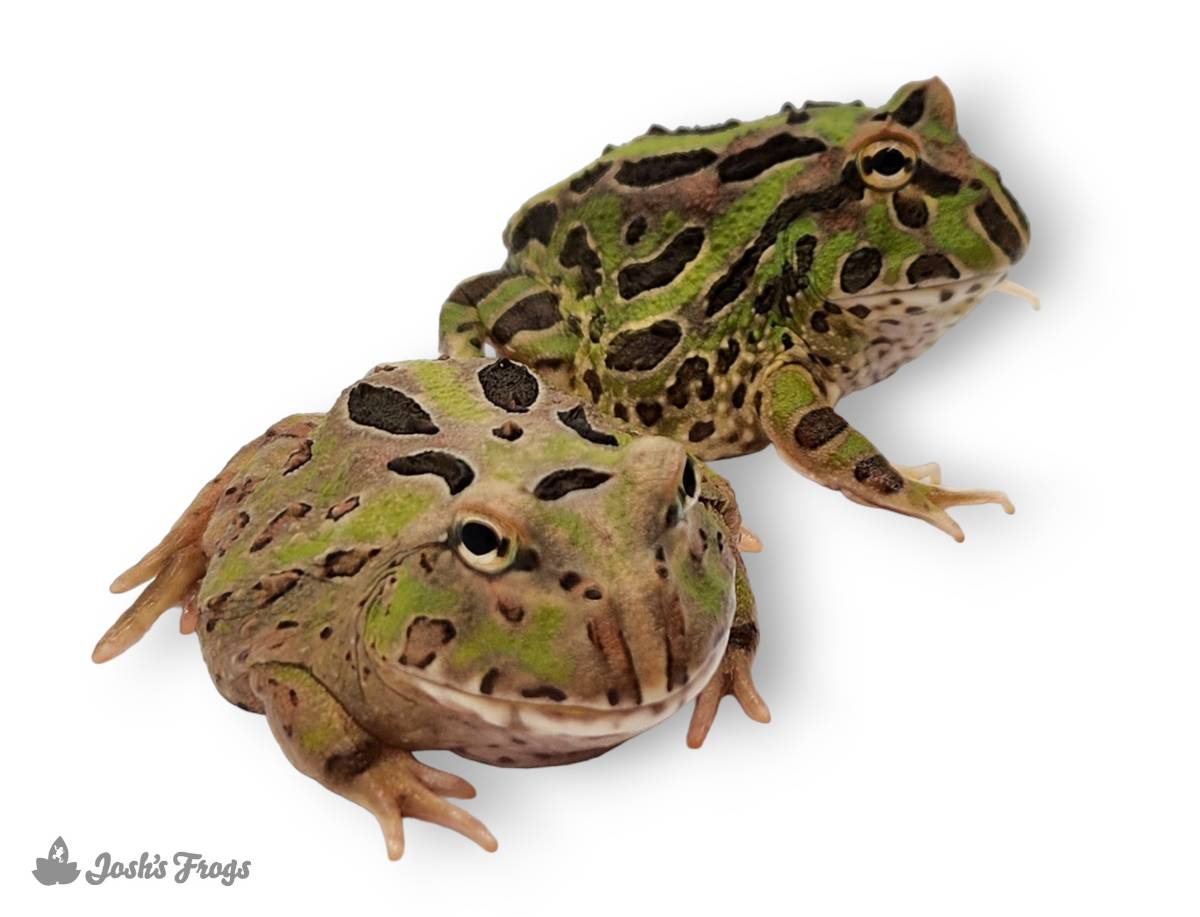Josh's Frogs
Pac-Man Frog Care Sheet
Pac-Man Frog Care Sheet

Defining Characteristics
- Experience Level: Beginner
- Color depends on species
- Fair amount of care
- Size up to 8 inches (20 cm)
- Solitary (should be kept singly)
- Not for handling
Pac-Man Frogs (Ceratophrys ornata)
Pac-Man frogs come in a variety of color forms and are known by many common names (Argentine horned frogs, ornate horned frogs, horned frogs). Wild-caught imports continue to come in, but captive-bred Pac-Man frogs are readily available through many online vendors as well as at most brick-and-mortar pet stores. Due to their forgiving nature, ease of care, and the availability of captive-bred specimens, Pac-Man frogs make great pets.
Size
Captive-bred baby Pac-Man frogs are sold at around the size of a quarter, and these frogs can reach adult size in 1 to 1.5 years. Adult males are smaller (2½ inches to 4 inches in length, depending on the species) than female Pac-Man frogs, which can reach lengths of 4 to 7 inches.
Life Span
Under optimal conditions, Pac-Man frogs can live approximately 15 years in a captive environment.
Housing
Pac-Man frogs are sit-and-wait predators. They spend the majority of their time burrowed into the substrate with their eyes (and horns in some species) above the substrate. Because of this, caging does not need to be spacious. Babies can be kept in small, plastic reptile enclosures, whereas adults can be caged in enclosures of 10 to 20 gallons.
Pac-Man frogs love to burrow. Therefore they require a substrate that they can dig in to. Coir (ground coconut) makes a great substrate and is available at most pet stores. This substrate should remain damp, but not soaking wet.
Many people recommend keeping a water bowl in with the Pac-Man frog. I have kept Pac-Mans with and without water bowls. As long as you keep the substrate moist, a water bowl isn’t a necessity.
Pac-Man frogs will also use hiding spots, so they should be provided. Live plants, such as Pothos, not only provide hiding spots but also help to process feces and CO2.
Keep Pac-Mans at a temperature of 72 to 78°F.
Food
One quality that sets Pac-Man frogs apart from other frogs is their voracious appetite. A staple of crickets and/or roaches is best, but they can also eat fish, worms and even small mice. The amount you should feed them is based on the size and temperature of the frog. If allowed to cool down and dry out a little bit, Pac-Man frogs can enter a brumation state where they will refuse food.
The best gauge for how much to feed your Pac-Man frog is to study your frog’s appearance. You want your Pac-Man to be round. If your frog is looking unnaturally large, cut back on the feeding. In nature Pac-Man frogs gorge themselves when food is plentiful to compensate for when food is scarce.
Make sure you're dusting your Pac-Man frog's food with an appropriate vitamin/mineral supplement - Josh's Frogs Pac-Man Frog Supplement Bundle is a great place to start.
Handling and Temperament
Pac-Man frogs have teeth, and large Pac-Man frogs can and will draw blood if you stick your hand in front of them. As with all frogs, handling should occur only when absolutely necessary, as their skin is very sensitive.
Behavior
Keep Pac-Mans as a solitary frog (1 per tank). They are aggressive eaters and can sometimes nibble on tank mates.
Live Pac-Man frogs are sometimes mistaken for dead Pac-Man frogs. When their substrate dries out and/or food is scarce, the Pac-Man will encase itself in a tough outer skin to protect it from drying out. They won't move and they look like they are dead. Once rehydrated, however, they will shed this outer skin (and eat it!).
